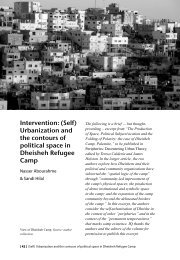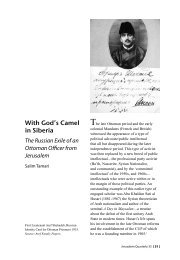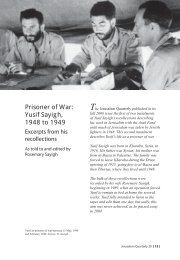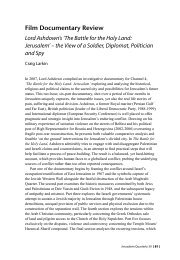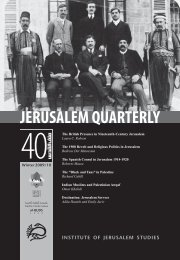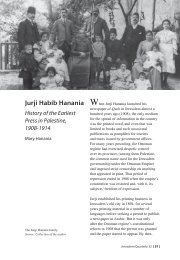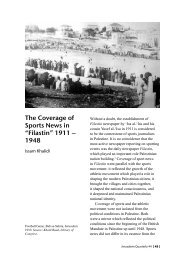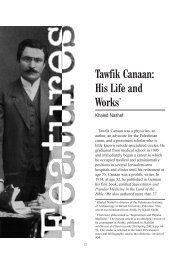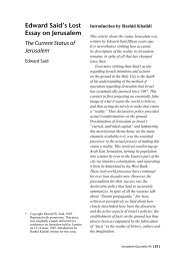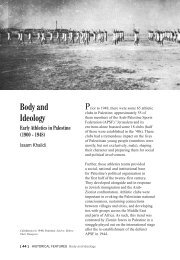PLUNDERING PALESTINE - Jerusalem Quarterly
PLUNDERING PALESTINE - Jerusalem Quarterly
PLUNDERING PALESTINE - Jerusalem Quarterly
Create successful ePaper yourself
Turn your PDF publications into a flip-book with our unique Google optimized e-Paper software.
short of the 1967 occupation of remaining rump-Palestine and other Arab lands, most<br />
notably the Syrian Golan Heights.<br />
But Kletter goes further than that: while indicting certain military men for their<br />
excesses, he by and large exonerates Israel for acts which, he claims, were inevitable<br />
given the state of war and the material needs of the immigrants. Although he severely<br />
criticizes the politicization of works on archaeology, he does not hesitate to render<br />
judgment on the question of human, and therefore archaeological, intent. If we are<br />
to believe him, the massive destruction of Palestinian homes, monuments and places<br />
of worship was a nearly accidental byproduct of violence after 1947. There was no<br />
intention of carrying out ethnic cleansing, just a few late isolated cases of it (p. 42).<br />
And if subsequently, the authorities proceeded to raze villages in their entirety, it was<br />
first because of “embarrassment” and later to hide the unsightly blight that might<br />
disturb tourists, notably along the road from the coast to <strong>Jerusalem</strong>. The old Arab<br />
city of Tiberias was razed, along with its mosques and synagogue. On the other hand,<br />
the Arab village of Bar’am, whose inhabitants never left the country, was entirely<br />
destroyed in order to “accentuate” the synagogue (p.61).<br />
He cites various authors regarding volition or intent, selectively, and finds there was<br />
none. One of them is the ur-Benny Morris. But not the Benny Morris of 2004 (The<br />
Birth of the Palestinian Refugee Problem Revisited) who had meantime become<br />
unequivocal in judging that there had been an expulsion policy and, in his infamous<br />
Ha’aretz interview in January of the same year, stated that Ben Gurion, who led that<br />
policy, had finally gotten cold feet and not finished the job and gotten rid of all Arabs<br />
from “the whole Land of Israel, as far as the Jordan River…”, as he should have.<br />
Why is this important? First of all, because it addresses the question of credibility<br />
regarding the work as a whole, and most particularly, the choice of archival<br />
documents. Historians (and this designation is not a corporate one; history today<br />
works through a multiplicity of media and sources: written, oral, pictorial, fictional,<br />
and so on) always choose carefully among available documents – so much so that<br />
there is some credibility to the slogan: “archives lie.” They lie at the source and<br />
they lie upon their publication. At the source because they are drafted and crafted<br />
by a certain class of people (consuls, ministers, civil servants and other members of<br />
the elite) and not the countless marginalized persons whose situation they purport<br />
to describe. 1 And they lie by virtue of the criteria of selection employed by those<br />
intellectuals who choose, present and interpret them for the public. This is why a close<br />
critical reading of documents, as well as the concept of intersecting networks (“who<br />
said what, when and to whom?”), has become vital as a criterion for verification in<br />
the social sciences. And when verifiable secondary sources are selected or distorted,<br />
it is a reasonable induction that the material as a whole will be as well. Circumstantial<br />
evidence is found in the author’s having presented the work to the censor for approval.<br />
<strong>Jerusalem</strong> <strong>Quarterly</strong> 33 [ 73 ]



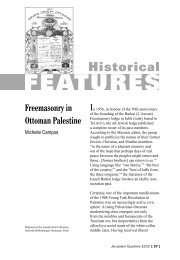
![In Search of Jerusalem Airport [pdf] - Jerusalem Quarterly](https://img.yumpu.com/49007736/1/180x260/in-search-of-jerusalem-airport-pdf-jerusalem-quarterly.jpg?quality=85)
